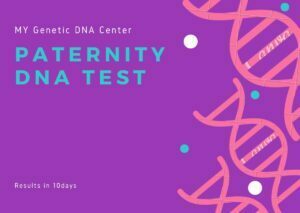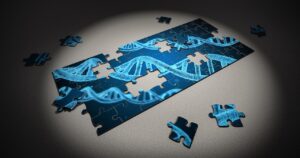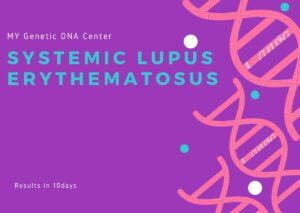Introduction to EPSTEIN-BARR VIRUS EARLY RNA (EBER-ISH):
The Epstein-Barr Virus Early RNA (EBER-ISH) – In-Situ Hybridization test is a specialized molecular pathology technique designed to detect Epstein-Barr Virus (EBV) within tissue samples with high sensitivity and specificity. EBV, a member of the herpesvirus family, is linked to a wide range of malignancies and lymphoproliferative disorders, including Hodgkin lymphoma, Non-Hodgkin lymphoma, nasopharyngeal carcinoma, gastric carcinoma, and post-transplant lymphoproliferative disease. The test focuses on identifying EBV-encoded small RNAs (EBER-1 and EBER-2), which are expressed abundantly in latently infected cells, even when the viral load is minimal.
Using the In-Situ Hybridization (ISH) method, this assay not only confirms the presence of EBV but also pinpoints the exact location of infected cells within the tissue architecture, providing crucial insight for accurate diagnosis and classification. Unlike serological or PCR-based methods that detect viral components in blood or extracts, EBER-ISH allows visualization of EBV directly in the context of tissue morphology, enabling pathologists to correlate infection status with cellular and structural details. This precision is particularly valuable in distinguishing EBV-positive tumors from EBV-negative subtypes, aiding in determining prognosis, selecting appropriate treatment strategies, and understanding the role of EBV in disease progression. Since most EBV-associated malignancies stably and consistently express EBER, clinicians regard this test as the gold standard for histopathological EBV detection, making it an indispensable tool in modern diagnostic oncology and research.
What is the EBER-ISH test?
The EBER-ISH test, or Epstein-Barr Virus Early RNA – In-Situ Hybridization, uses a highly specialized laboratory technique to detect Epstein-Barr Virus (EBV) within tissue samples at the cellular level. This method targets EBV-encoded small RNAs, specifically EBER-1 and EBER-2, which infected cells produce abundantly during the latent phase and keep stable. Using in-situ hybridization, the test enables pathologists to visualize viral RNA directly within the tissue’s structural context, allowing them to pinpoint exactly which cells the virus infects.
This makes the EBER-ISH test especially valuable for diagnosing EBV-associated diseases, such as Hodgkin and Non-Hodgkin lymphomas, nasopharyngeal carcinoma, certain gastric cancers, and post-transplant lymphoproliferative disorders. Unlike other EBV detection methods that analyze blood or fluid samples, EBER-ISH provides precise localization of the virus, which is crucial for confirming diagnoses, guiding treatment planning, and assessing prognosis. Its high sensitivity and specificity have established it as the gold standard for EBV detection in tissue-based pathology.
Why is this test done?
Clinicians perform the EBER-ISH test to accurately detect and localize Epstein-Barr Virus (EBV) within tissue samples, providing critical diagnostic and clinical information. EBV links to a wide range of conditions, including Hodgkin lymphoma, certain subtypes of Non-Hodgkin lymphoma, nasopharyngeal carcinoma, some gastric cancers, and post-transplant lymphoproliferative disorders. In many of these diseases, confirming the presence of EBV can influence diagnosis, classification, prognosis, and treatment strategies. Since EBV often persists in a latent state within specific cells, conventional tests like blood-based serology or PCR may not always reveal its presence in affected tissues.
The EBER-ISH method overcomes this limitation by directly detecting EBV-encoded small RNAs in tissue sections, enabling pathologists to identify the exact cells harboring the virus and observe its distribution within the tissue architecture. This targeted insight is particularly valuable when differentiating EBV-related conditions from non-EBV cases that may present with similar histological features, ensuring that patients receive the most accurate diagnosis and the most appropriate care plan.
How does the test work?
The EBER-ISH test works by using a molecular technique called In-Situ Hybridization (ISH) to detect Epstein-Barr Virus-encoded small RNAs (EBERs) directly within tissue samples. Latently EBV-infected cells abundantly express EBERs, making them highly reliable targets for detection. During the procedure, technicians apply a labeled complementary nucleic acid probe specifically designed to bind to EBER sequences onto thin tissue sections. The probe hybridizes, or pairs, with the viral RNA present in the cells. After hybridization, a colorimetric or fluorescent detection system visualizes the infected cells under a microscope. This method allows pathologists to observe the exact location and distribution of EBV-positive cells within the tissue’s structural context, preserving histological details. Its high specificity and sensitivity enable the test to detect EBV even when viral load is extremely low, making it an essential diagnostic tool for identifying EBV-associated diseases and guiding accurate clinical decisions.
How is it different from other EBV tests?
The EBER-ISH test differs from other EBV tests primarily in its ability to detect latent EBV infection directly within the tissue architecture, offering both visual localization and high sensitivity. Unlike blood-based tests such as EBV serology, which measure antibodies, or PCR assays, which quantify viral DNA, EBER-ISH targets EBV-encoded small RNAs (EBERs) that latently infected cells abundantly express, even when viral replication is inactive and viral DNA levels remain undetectable.
This makes it especially valuable in diagnosing EBV-associated cancers and lymphoproliferative disorders, where the virus often persists in a latent state. Furthermore, this technique lets pathologists identify the exact cells infected and observe how the virus distributes within the tissue, preserving the histological context—something molecular tests on extracted nucleic acids cannot provide. This combination of molecular precision and tissue-level visualization gives EBER-ISH a unique role in clinical diagnostics, making it the gold standard for confirming EBV presence in tissue biopsies.
When is the EBER-ISH test recommended?
Healthcare providers recommend the EBER-ISH test when they suspect Epstein-Barr Virus (EBV)–associated disease, especially in cases of lymphoproliferative disorders and certain cancers. They frequently order it to evaluate Hodgkin lymphoma, Non-Hodgkin lymphoma, nasopharyngeal carcinoma, post-transplant lymphoproliferative disorder (PTLD), and other tumors linked to EBV. They also use the test when patients present with unexplained lymph node enlargement, persistent fever, or abnormal tissue findings and when conventional tests fail to provide a clear diagnosis.
In immunocompromised individuals, such as organ transplant recipients or patients undergoing chemotherapy, EBER-ISH helps identify EBV-driven proliferations early, enabling timely intervention. Clinicians often prefer this test when tissue biopsy samples are available and require histological evaluation because it detects latent EBV infection even when blood viral load remains low or absent. Ultimately, it is a key diagnostic tool when clinical suspicion, patient history, and preliminary investigations suggest an EBV link but confirmation within the tissue context is critical for accurate diagnosis and targeted treatment planning.
How is the sample collected?
Doctors obtain the EBER-ISH test sample through a tissue biopsy from the affected area, guided by the patient’s symptoms and suspected condition. The biopsy may involve removing a small tissue piece from a lymph node, tumor, or lesion using surgical excision, core needle biopsy, or fine needle aspiration. Technicians then preserve the tissue in formalin and embed it in paraffin wax to maintain its structure for microscopic analysis. Sometimes, labs use archived paraffin-embedded samples. They send the specimen to a specialized pathology lab, where experts perform In-Situ Hybridization (ISH) to detect Epstein-Barr Virus–encoded RNA (EBER) within cells. Staff follow strict protocols to prevent degradation or contamination, ensuring accurate results. This careful process helps localize the virus precisely within the tissue, supporting accurate diagnosis and clinical decisions.
How long does it take to get results?
The laboratory’s workload, case complexity, and need for additional confirmatory analyses can affect the turnaround time for the EBER-ISH test. In most cases, results are typically available within 5 to 10 business days after the tissue sample reaches the pathology laboratory. This time frame includes the processes of preparing the tissue sections, performing the In-Situ Hybridization (ISH) procedure, and conducting a detailed microscopic examination to identify the presence and location of Epstein-Barr Virus–encoded RNA (EBER). If the case is complex or requires further immunohistochemical or molecular testing for correlation, the reporting time may extend slightly. Pathologists carefully review the findings to ensure accuracy, then share the final report with the referring physician. This detailed and precise process ensures that the results are not only technically accurate but also clinically meaningful, supporting the diagnosis, prognosis, and treatment planning for EBV-associated conditions.
What do the results mean?
The results of the EBER-ISH test provide critical information about the presence or absence of Epstein-Barr Virus (EBV) within the examined tissue, which can significantly influence diagnosis and treatment decisions. A positive result shows that the test detected EBV-encoded small RNAs (EBERs) in the cells, confirming that the virus infects those cells. This finding supports the diagnosis of EBV-associated conditions such as certain lymphomas (including Hodgkin and Non-Hodgkin types), nasopharyngeal carcinoma, gastric carcinoma, or post-transplant lymphoproliferative disorders.
The test not only confirms infection but also reveals the specific location and distribution of EBV within the tissue, helping pathologists distinguish between EBV-driven disease and other conditions with similar appearances but without viral involvement. A negative result means the test did not detect EBERs in the tissue sample, indicating that EBV is unlikely to play a role in the disease process at the tested site. However, a negative result does not entirely rule out EBV involvement elsewhere or at different disease stages. Therefore, clinicians interpret EBER-ISH results alongside other clinical, histological, and laboratory findings to form a comprehensive diagnosis and develop an effective treatment plan tailored to the patient’s condition.
Can this test help in treatment decisions?
Yes, the EBER-ISH test plays a significant role in guiding treatment decisions for patients with suspected Epstein-Barr Virus (EBV)–associated diseases. By precisely identifying the presence and distribution of EBV within tissue samples, this test helps clinicians distinguish between EBV-positive and EBV-negative forms of various cancers and lymphoproliferative disorders. This distinction is crucial because EBV-associated tumors often have different biological behaviors, prognoses, and responses to therapy compared to EBV-negative cases. For instance, in certain lymphomas, the detection of EBV may suggest a more aggressive disease course or indicate the need for tailored treatment strategies, including antiviral therapies or immunomodulatory approaches.
Additionally, knowing a tumor’s EBV status can influence decisions about the intensity of chemotherapy, radiation therapy, or the use of targeted agents. In transplant recipients, EBER-ISH helps identify EBV-driven post-transplant lymphoproliferative disorders, guiding timely immunosuppressive adjustments or specific treatments to manage viral activity. Overall, the detailed information provided by EBER-ISH supports personalized medicine by enabling clinicians to optimize treatment plans, improve patient outcomes, and monitor disease progression or response to therapy more effectively.
Is the test reliable?
Yes, clinicians highly trust the EBER-ISH test and consider it the gold standard for detecting Epstein-Barr Virus (EBV) in tissue samples due to its strong reliability. Its high sensitivity and specificity stem from its ability to directly visualize EBV-encoded small RNAs within infected cells, even when viral levels are low. This precision allows for accurate localization of the virus in the tissue’s cellular context, minimizing false positives or negatives. Pathology laboratories worldwide widely use the test and rely on it to diagnose EBV-associated diseases, making clinicians and pathologists trust it as a valuable tool.





